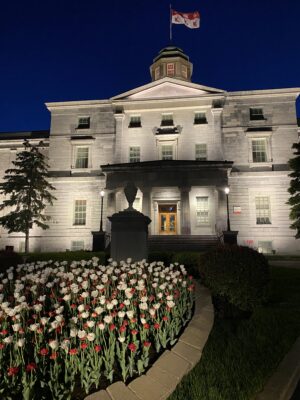
As more nightlife returned to the downtown in recent months, chances are Montrealers will have found McGill’s McCall MacBain Arts Building even more striking than ever before.
The building’s façade is now illuminated by over 50 light fixtures that bring out the architectural features of this iconic structure at the end of the campus main road.
The project, a legacy of McGill’s 200th anniversary, was made possible thanks to a generous donation from McGill alumna and longtime supporter Susan Riddell Fitzpatrick, BCom’61. As a student, Ms. Fitzpatrick had several courses at the Arts Building and remembers it as the focal point of the campus and an exciting meeting place, where students would congregate before and after class, both inside and outside on its front steps.
“The building is so gorgeous, but the campus road was remarkably dark and uninviting. A huge number of people in Montreal walk through the campus on their way downtown, not just students,” Ms. Fitzpatrick says.
Hence, she proposed using her donation to light up the main campus road in front of the McCall MacBain Arts Building. The original thought was to install lighting in the trees during the holiday season before the decision was made to go for something more permanent.
The monumental lighting installation has simultaneously revealed the building’s details in the evening and improved the campus’s safety at night. Ms. Fitzpatrick says she was “exceptionally happy” with the result. She hopes the brightness created by the new lighting will be even more appreciated during the winter when it gets dark earlier.
Monumental installation more work than meets the eye
Previously, there were only two lampposts in front of the main entrance of the building, stemming from the time of the Molson Hall wing’s construction in 1862. Other lighting around the structure served primarily a security function and did not highlight the building’s rich architecture.
The year-long project was led by the Design Services and Project Management teams at Facilities Management and Ancillary Services (FMAS), in collaboration with CS Design, who created the lighting design.
The elegance of the result conceals, to a certain extent, the amount of work achieving it required. Extensive planning was necessary to ensure that the architectural features were spotlighted, underground work was done to prepare the infrastructure supporting the light fixtures, electric conduits had to be installed and permits needed to be obtained from the City of Montreal.
“When the design of the project started in 2019, no permits or certificates were required. However, the Ville-Marie borough adopted a new bylaw for exterior lighting in January 2021,” explains Emmanuelle Lapointe, Director, Design Services, FMAS. It took around three months to obtain the authorization certificate. “The two evaluation criteria to be granted the certificate are to minimize light pollution and to highlight the architectural characteristics of the building. Our project aligned perfectly with both objectives.”
As all building owners, McGill must contend with the disruptions in supply chains experienced in all sectors at the moment and this project was no exception. “The most challenging part of this project was the delays caused by material, equipment and labour shortage. The work on the exterior required some expensive machinery that was scarcely available,” explains Simon Lacoste, Project Management, FMAS. “Everyone involved put in extra hours, including weekends and evenings, to complete the project in time.”
An even more pedestrian-friendly campus
For Emmanuelle Lapointe, the illumination of the McCall MacBain Arts Building “falls in line with the move towards creating a pedestrian-friendly environment on campus,” which began with the redesign and renovation of the Roddick Gates area and the intersection with Sherbrooke Street (in collaboration with the City of Montreal) in 2016. Then, a couple of years ago, the lower campus main road was redesigned and rebuilt with new lighting and benches and a single-level surface. FMAS will move forward with a similar project on the upper section of the main road in 2023.
FMAS collaborators on this project included: CS Design, FAMG Construction, Potvin électrique and Tétratech.
About the McCall MacBain Arts Building
Construction of the iconic building that is now home to McGill’s Faculty of Arts began in 1839. Initially known as the McGill College building, it became known as the Arts Building as the school evolved into McGill University. The first iteration of the building was completed in 1843, making it the University’s oldest structure. Numerous modifications were made over the years.
The recognizable façade known today was completed in 1862 with the addition of Molson Hall, a west-wing extension named for early benefactor William Molson, along with a connection to the building that is now its east wing. Once known simply as “the wing,” this building was named Dawson Hall in 1947 for Sir John William Dawson, McGill’s fifth principal, who was instrumental in developing McGill’s standing and improving its downtown campus.
It wasn’t until 1925 that architects Fetherstonhaugh and McDougall replaced the old wooden porch with the Doric limestone portico and completed renovations to the main lobby that made it the grand hall we know today.
In 2019, John and Marcy McCall MacBain of the McCall MacBain Foundation made the largest single gift to a Canadian university at the time, leading the Arts Building to be renamed the McCall MacBain Arts Building.
